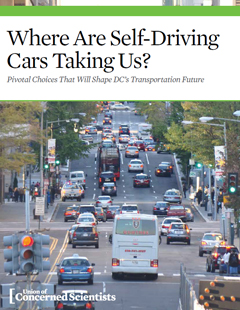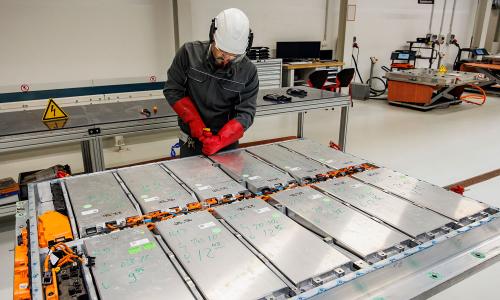Self-driving cars—also known as autonomous vehicles (AVs)—are quickly moving from a design and testing phase to our streets. AVs have the potential to dramatically change cities and towns. Whether this change will improve people’s lives will depend on the policies we set in place to govern vehicles, roads and transit systems.
The Union of Concerned Scientists partnered with the transportation firm Fehr & Peers to examine several scenarios of the effects of AVs on the Washington, DC, metropolitan region transportation system in 2040.
- We asked how differences in vehicle occupancy and investments in mass transit would affect congestion and job access for different populations across the region.
- We compared the effect on low-income people and communities of color in the region to understand whether AVs would affect access to quality transportation, increase congestion and result in greater environmental pollution.
Key findings
- Pooling leads to greater job access: AVs operated as part of higher-occupancy pooled fleets would more than double the number of jobs accessible by car. If AVs are not pooled, they would increase congestion, and this would lead to a loss of 80 percent of the job-access benefit.
- Improving transit leads to greater job access: Investments in a better transit system would reduce congestion on roadways and would double the jobs accessible by transit. It would also ensure that people retain the choice of whether to use a car or mass transit.
- AVs will increase driving: The introduction of AVs would cause the total amount of driving to increase by as much as 66 percent relative to the 2040 baseline year. In scenarios that include policies to encourage pooling and transit investments, increases in total driving would be lower (46 percent). In the absence of a rapid transition to electric vehicles (EVs), increased driving would exacerbate global warming.
- Congestion increases in disadvantaged communities: People living in low-income neighborhoods and communities of color would be subjected to a huge increase in exposure to congested driving in all AV scenarios, with 4 to 7 times as much congested driving as in the projected 2040 regional average. Exposure in these neighborhoods was about 50 percent higher than in the region as a whole. This can make it harder to get around and increase harmful local air pollution, if AVs are not electrified.
Policy recommendations
Our findings and other research demonstrate that policymakers must act as soon as possible to mitigate the risks and maximize the opportunities of AVs. The following policy recommendations can steer the DC metro region toward a more equitable, efficient, and clean transportation future:
- Encourage pooling: AVs can potentially increase congestion. AVs deployed predominantly as part of shared transportation services that pool riders going to similar destinations can move more people in fewer vehicle trips than would AVs following today’s prevailing single-occupancy usage patterns. Pooling AVs could thus reduce congestion that would otherwise compromise their potential benefits.
- Improve and modernize mass transit: Continued investment in and enhancement of high-capacity mass transit can ensure that AVs and mass transit complement one another and support smart growth goals.
- Power with electricity: AVs will increase driving.Rapid transition to EVs is also required to ensure AV technology does not undermine efforts to reduce global warming and local air pollution.
Downloads
Citation
Ezike, Richard, Jeremy Martin, Katherine Catalano, Jesse Cohn. 2019. Where Are Self-Driving Cars Taking Us?. Cambridge, MA: Union of Concerned Scientists. https://www.ucsusa.org/resources/where-are-self-driving-cars-taking-us




